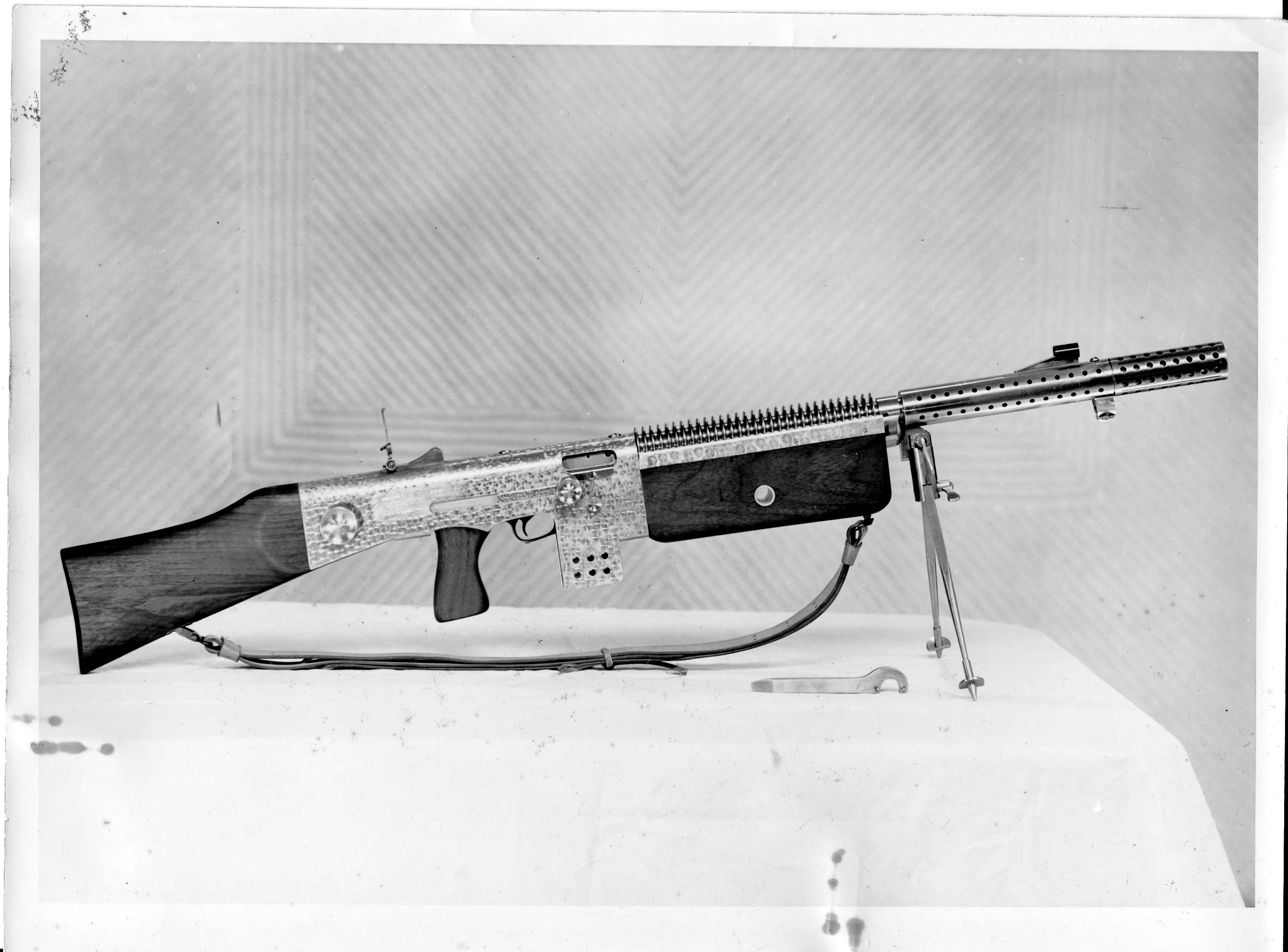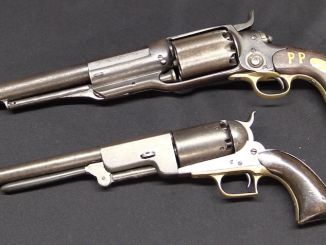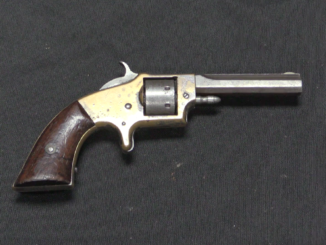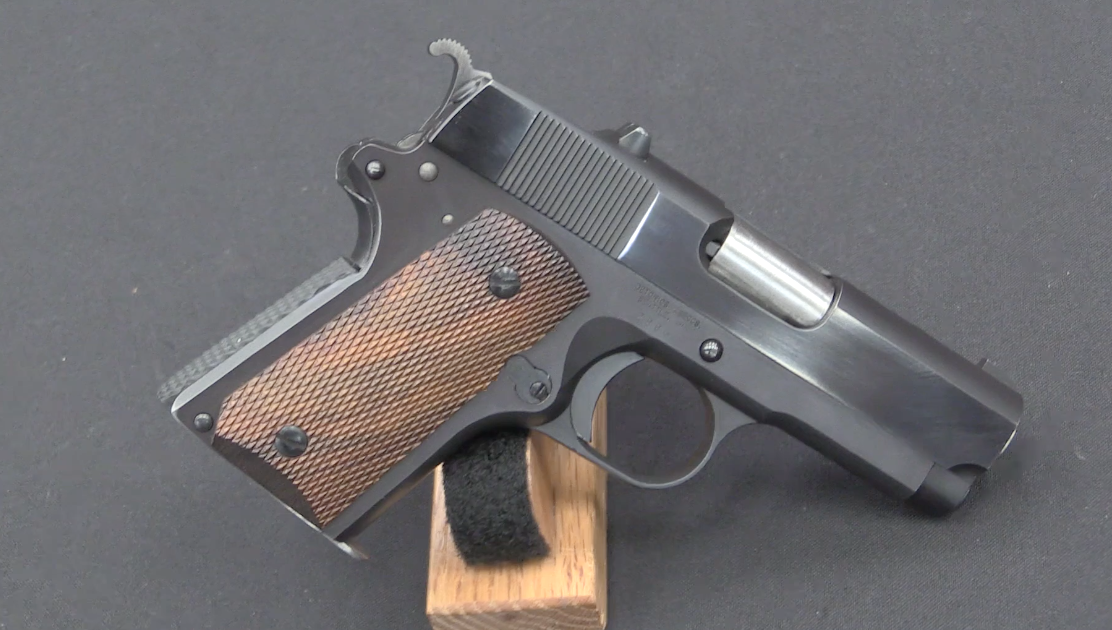Does anyone recognize this rifle? It was designed by Fred Woodhall in 1945 (after his unsuccessful entry in the M1 Carbine trials), and now his son Tad Woodhull is trying to track it down. If you know anything about its current whereabouts, please email me!





Looking at it in close-up, I have a sneaking suspicion that under the engine-turned casing and finned barrel with a flash-hider extension, it’s basically another Winchester M1907/M1910 alteration, like Woodhull’s submachine gun of 1940-41.
Note the bolt, the trigger guard, the position of the front sight, and particularly the forearm. The latter looks like it is oversized to accommodate the bolt weight typical of the M’10 in .351 and .401 WSL, to reduce bolt velocity due to the blowback action.
The external bolt cocking slide on the right, ala’ the left-mounted one o the BAR, would require little more than a slot machined into the right side of the M’10 receiver.
Lastly, the magazine housing seems to be perfectly sized for the Winchester M’10 magazine, but the wrong dimensions for any other common magazine of the day.
I’m guessing it was a .351 WSL caliber. Other cartridges might have been dimensionally adaptable, but with the possible exception of the German 7.9 x 33 Kurz or the .30 Carbine I wouldn’t want to try any of the candidates in what is still fundamentally a (barely) retarded-blowback action. (See VG1-5 and Cristobal carbine.)
cheers
eon
“I’m guessing it was a .351 WSL caliber.”
It is quite probable considering drawings for US Patent 2375721 A titled Automatic rifle
http://www.google.com.gt/patents/US2375721
by Woodhull Frederick W, there are several novel features described in patent, including magazine:
Another object is to provide a novel and improved simple cartridge magazine whereby a plurality of cartridges can be fed singly in rapid succession to the loading mechanism of the rifle with a minimum of possibility of jamming of the cartridges or failure of supply thereof.
Such choice of cartridge is quite head-scratching, Patent I linked was filled in in June 1940, at that time, as far I know, none military forces used .351 Winchester (or .401 Winchester?) as their default cartridge? Why it is called Export Model?
I think it was called an export Model because nobody in the u.s. military was interested in it. The Woodhull “SMG” failed the Army trials in 1940, so this was probably noty seen as a serious proposition by the Ordnance Board.
As to why it’s still a .351, that’s most likely mainly because if you start with a Winchester M1910, it’s next to impossible to convert it to any caliber other than the .351 or .401 and get it to function reliably.
The dimensions and masses of the components (bolt, etc.) were made specifically for reliable functioning with those exact loads. IIRC, there were two different bolt weights for the forearm, one for each cartridge, with the .351 needing the heavier one oddly enough because of its higher muzzle velocity.
Like the P.08, which is designed to function with a 125 grain bullet at 1250 feet per second, the Winchester M’10 functions very well with its designed cartridges and loads. With anything else, it sulks.
Curiously enough, the .351 round, which is semi-rimmed, will chamber and fire in a .357 Magnum revolver. However, I don’t think a .357 cartridge will do the same in a Winchester M’10.
Probably a good thing, too.
cheers
eon
“.351 round, which is semi-rimmed, will chamber and fire in a .357 Magnum revolver”
It is rather impossible unless said revolver has very longer cylinder that it needs to be – .351 Winchester overall length is 1.906″ when .357 Magnum overall is length 1.59″ that is .316″ difference.
“.351 round, which is semi-rimmed”
The semi-rimmed nature of that cartridge (and other from “family”) might be easily explained by fact that whole line of rifles started from .22 rim-fire rifle: Winchester Model 1903
https://en.wikipedia.org/wiki/Winchester_Model_1903
notice that it don’t fire .22 Long Rifle cartridge, but special cartridge – .22 Winchester Automatic – which is inside-lubricated unlike outside-lubricated .22 Long Rifle. This was done to prevent usage of black-powder cartridge in Model 1903, several years later, when .22 Long Rifle black-powder loading become past, Model 1903 was adopted for .22 Long Rifle and named Winchester Model 63.
Similar fears of black-powder misuse also lead Remington to design own special .22 rim-fire cartridge to use in Remington Model 16 rifle.
I’m going to guess that the novel features in the patent don’t have anything to do with the donor gun. The examiners could see what the donor was as well as we can.
Also now I notice that it patent there words as simple and inexpensive. When using such cartridge might be understand as trying to mate cartridge superior ballistic-wise to pistol one (.45 Auto) without need to use locking mechanism, I’m wondering who was target market? For basically weaker-cartridge LMG? Only similar weapon which I am aware of is Danish Weibel M/1932 firing 7×44 cartridge
http://guns.wikia.com/wiki/Weibel_M/1932
according to Стрелковое оружие Второй Мировой. Коллекционное издание by Марин Милчев,Максим Попенкер it fired 7,78g Spitzer bullet at 660m/s
According to the patent, disconnecting mechanism depends on a precisely screw adjusted gap through which the trigger acts. In case of faulty adjustment or any screw loosening, rifle would go to “Hammer Follow” without discharging. Not seeming reliable.